Dec. 1, 2022
Publications

🌐 follow Marie-Anne Frison-Roche sur LinkedIn
🌐subscribe to the Newsletter MAFR Regulation, Compliance, Law
____
► Full Reference: M.-A. Frison-Roche, "Contrat de compliance, clauses de compliance", Chronique of Compliance Law, D.2022, p.2115-2117.
____
📝reac the article (this article is written in French)
____
► English summary of the article: Compliance Law is often seen only as an obligation to comply with regulations. Contract Law is masked by the study of texts and sanctions. Civil liability cases are beginning to highlight the commitments of companies, acts of will. It remains to discern the importance of contracts.
First, there is a specific contract: the "compliance contract". Its purpose is to provide a third party with a service, the means for the company to "comply" with the legal systems requirements ("contract of conformity"), and/or to enable the company to achieve the monumental goals that characterize Compliance Law (contract of compliance). The interpretation and the regime of these compliance contracts must be marked by the Compliance Law that permeates it. Secondly, there are a multitude of stipulations aimed at conformity and Compliance.
____
🚧read the working paper written in English: Compliance contract, Compliance stipulations
____
📚read the other articles published in this chronique of Compliance Law published in the Recueil Dalloz.
________

Nov. 18, 2022
Publications

♾️ suivre Marie-Anne Frison-Roche sur LinkedIn

♾️s'abonner à la Newsletter MAFR Regulation, Compliance, Law
____
► Référence complète : M.-A. Frison-Roche, "Ce qui est commun à la Compliance, au Contrat et aux Parties contractantes". Éléments pour la synthèse", in Journal of Regulation & Compliance (JoRC) et Université de Nîmes Compliance et Contrat : les acteurs et leurs stratégies, Nîmes, 18 novembre 2022.
____
🧮 lire le programme complet du colloque
____
🏗️Ce colloque prend place dans le cycle de colloques, organisé par le Journal of Regulation & Compliance (JoRC) et les Universités qui sont ses partenaires académiques, pendant l'année 2022/2023 autour du thème général L'obligation de compliance.
____
► des difficultés techniques et d'organisation du temps ont empêché l'exposé oral de la synthèse réalisée sur le vif au terme de l'audition des différentes contributions faites dans la journée. Il en reste donc les notes prises sous la forme d'un document de travail, auquel le lendemain ont été ajoutées quelques notes en pop-up pour aller plus loin.
____
► Résumé du document de travail résumant le colloque : En premier lieu, il convient de ne pas confondre les trois piliers dont l'enjeu est de percevoir l'articulation. En effet pour mesurer les stratégies des parties par l'usage qu'elles font du contrat au regard de leurs obligations de compliance, il faut distinguer leurs obligations de conformité et leurs obligations de compliance; distinguer dans les contrats les éléments subjectifs (que sont les parties) des éléments objectifs (que sont les clauses), distinguer le contrat au sens technique des mouvements de "contractualisation" qui renvoie à une appellation plus large et plus vague, distinguer entre la partie juridiquement contractante, personne morale ou personne physique, de l'entreprise, souvent désignée comme le sujet du Droit de la Compliance, distinguer l'usage que celle-ci fait de son pouvoir normatif de l'usage qu'elle fait de son pouvoir contractuel, distinguer les techniques juridiques de régulation au sens strict de ce qu'on désigne souvent d'une façon plus générale et plus vague comme un pouvoir de "régulation". Ces distinctions sont d'autant plus bienvenues que s'agissant des parties contractantes, il convient de distinguer les parties au contrat et les "parties prenantes" telles que le Droit de la Compliance les considère, l'ensemble de ces distinctions et articulations montrant qu'à première vue le Droit de la Compliance montrant plutôt l'entreprise assujettie dans un rapport avec la norme unilatéralement édictée, le contrat ne lui serait pas forcément l'instrument le plus naturellement adéquat.
Pourtant, en deuxième lieu, les clauses de compliance, voire les contrats de compliance, ont été multipliées par les entreprises parce que c'est un moyen pour elles de satisfaire leurs obligations légales de compliance en se créant, par le contrat, des débiteurs qui exécutent des prestations de compliance. Ainsi, c'est parce qu'il est assujetti légal qu'il devient créancier contractuel tandis que son cocontractant en devient débiteur parce que sa profession l'implique ou parce que sa position dans la chaîne de valeur l'implique.
En troisième lieu, les créanciers et les débiteurs contractuels d'un contrat de compliance ou d'une clause de compliance peuvent être concrètement saisis, comme le font les textes eux-mêmes qui ne visent que les opérateurs cruciaux, les contrats distinguant parmi les parties des catégories concrètement distinctes.
____
🔓Lire les développements du document de travail, constituant la synthèse du colloque, ci-dessous ⤵️
Nov. 18, 2022
Conferences
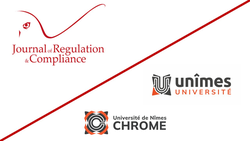
♾️ suivre Marie-Anne Frison-Roche sur LinkedIn
♾️s'abonner à la Newsletter MAFR Regulation, Compliance, Law
____
► Référence complète : M.-A. Frison-Roche, "Le juge, tiers régulateur des obligations contractuelles de compliance", in Journal of Regulation & Compliance (JoRC) et Université de Nîmes, Laboratoire CHROME, Compliance et Contrat : les acteurs et leurs stratégies, Nîmes, 18 novembre 2022.
____
🏗️Cette conférence prend place dans le cycle de colloques, organisé par le Journal of Regulation & Compliance (JoRC) et les Universités qui sont ses partenaires académiques, pendant l'année 2022/2023 autour du thème général L'obligation de compliance.
____
🎤 consulter la synthèse également faite de ce colloque
____
🧮Consulter le programme complet de cette manifestation
____
🚧lire le document de travail servant de base à cette conférence
____
📝Cette conférence sera la base d'un article, à paraître dans un ouvrage qui en résultera, dans sa version française, dans la collection 📚Régulation & Compliance coéditée entre le JoRC et les Editions Dalloz, et dans sa version anglaise, dans la collection 📚Compliance & Regulation coéditée entre le JoRC et les Editions Bruylant.
____

Nov. 12, 2022
Publications


♾️ suivre Marie-Anne Frison-Roche sur LinkedIn
♾️ s'abonner à la Newsletter MAFR Regulation, Compliance, Law
____
► Référence complète : M.-A. Frison-Roche, Automated Compliance, a pertinent tool for Compliance Law, the whole, document de travail, novembre 2022.
____
📝Ce document de travail sert de base à une participation à un débat sur "Automated Compliance : "the" solution or "a" solution?, qui déroule dans le Sommet global de Gaia-X le 17 novembre 2022.
____
►Résumé du document de travail : s'appuyant sur la présentation préalablement faite au débat par un membre de la Commission européenne, il s'agit de souligner trois éléments qui montrent que l' Automated Compliance (ou Compliance by design) est à la fois un outil central, mais qu'il n'est un outil du Droit de la Compliance dont il ne saurait remplir par sa seule performance technologique toutes les fonctions dans un Etat de Droit.
En premier lieu, l'Union européenne semble en difficulté lorsqu'elle veut tout à la fois bâtir un système juridique qui lui est propre sur la base de Lois dont chacune est la pièce d'un gigantesque puzzle pour obtenir une industrie pérenne et autonome dans une économie numérique mondiale totalement renouvelée, ce qui fait peser sur les entreprises une charge considérable d'intégration de toutes ces règles du jeu, tout en affirmant qu'il faut alléger la charge que la "réglementation" fait peser sur elles.
En second lieu, la meilleure solution pour résoudre cette ambition contradictoire est effectivement dans la technologique, les algorithmes intégrant directement les réglementations. Mais plus encore, l'ensemble de ces textes reposent sur une autonomie laissée en Ex Ante aux entreprises européennes pour s'organiser entre elles afin de concrétiser les "buts monumentaux" que l'Union européenne a décidé d'atteindre, dont la réalisation d'un cloud souverain est au centre.
Ainsi la distinction et l'articulation d'un "Droit de la Compliance", défini par ces "buts monumentaux", dont lequel l'intelligence artificielle est un outil, le "tout" (Compliance Law) et la "partie" (Automated Compliance) est essentielle.
En troisième lieu, cette distinction et articulation est non seulement bénéfice mais elle est obligatoire. En effet, même si le Droit de la Compliance constitue une branche du Droit, elle fonctionne dans le système juridique générale, qui ne fonctionne que par l'esprit des textes, les outils algorithmiques ne capturant que la lettre de ceux-ci. Ces tribunaux sont et seront au cœur du Droit de la Compliance, le cas Schrems l'a bien montré. C'est pourquoi la Technologie et le Droit doivent travailler ensemble, et davantage à l'avenir, notamment parce qu'un outil pour l'effectivité du Droit ne pourra jamais rendre compte de la vie même du système juridique.
________
🔓Lire ci-dessous les développements⤵️
Oct. 26, 2022
Hearings by a Committee or Public organisation

🌐follow Marie-Anne Frison-Roche on LinkedIn
🌐subscribe to the Newsletter MAFR. Regulation, Compliance, Law
____
► Full Reference: M.-A. Frison-Roche, Audition as amica curiae by the Paris First Instance Civil Court, in summary proceedings, on the Compliance System and the place of the duty of vigilance in it, 26 October 2022
____
The hearing was held in the presence of two other amici curiae, also appointed by the Court: Professors Jean-Baptiste Racine and Bruno Deffains.
The hearing was requested by and on the initiative of the Paris First Instance Civil Court in connection with a dispute between associations and TotalEnergie, the former alleging breaches of due diligence by the latter, and the Court asking highly qualified individuals to shed light on the Compliance System and its implications.
_____
📝read the hearing report published on 27 October 2022 by Olivia Dufour (Actu-juridique)
📝read the article reporting on the hearing of 7 December 2022, representing the presentation of Compliance Law by MaFR, published on 7 December 2022 by Mathilde Golla (Les Echos)
📝read the article on the use of amicus curiae, starting with the use made in this case, published on 8 December 2022 by Nicolas Cayrol (Recueil Dalloz)
________
Oct. 23, 2022
Thesaurus : Doctrine
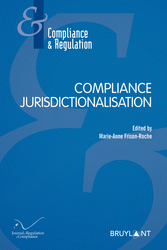
► Full Reference: F. Ancel, "Compliance Law, a new guiding principle for the Trial?", in M.-A. Frison-Roche (ed.), Compliance Jurisdictionalisation, Journal of Regulation & Compliance (JoRC) and Bruylant, coll. "Compliance & Regulation", to be published.
____
📘read a general presentation of the book, Compliance Jurisdictionalisation, in which this article is published
____
► Summary of the article (done by the Journal of Regulation & Compliance): Through this article, the author formulates a proposal: elevating the principle of compliance to the rank of leading principle of the trial. To support this, the author firstly emphasizes the convergence of the aims of compliance and the purpose of the trial. Indeed, emphasizing that Compliance Law does not oust either the State or the judge, as soon as compliance means that the person must keep their commitments and that the trial is also based on this principle that the parties must conform to the principles and to their own "speech", compliance thus becomes a trial leading principle.
In a second part of the article, the author illustrates his point in a very concrete way. First, the protocols of procedure which are drawn up by the courts and the bars are commitments which should justify a form of constraint which, if it should not have the same form and nature as that of the law, must all the same even have consequences when a party fails to do so. Secondly, relying on French case law which sanctions a party which had accepted the principle of an arbitration and then systematically hinders its implementation, the author suggests that under the principle of compliance can be grouped the notions for the instant scattered of loyalty, consistency (estoppel) and efficiency.
Thus, this "open practice" echoing the "open way" of a procedural principle of compliance brings out this one.
____
🦉This article is available in full text to those registered for Professor Marie-Anne Frison-Roche's courses
________
Oct. 20, 2022
Thesaurus : Doctrine

► Full Reference: F.-X. Train, "Arbitration and parallel proceedings exercised in Compliance Procedure", in M.-A. Frison-Roche, M.-A. (ed.), Compliance Jurisdictionalisation, series "Compliance & Regulation", Journal of Regulation & Compliance (JoRC) and Bruylant, to be published.
___
► the summary below describes the article that follows an intervention in the scientific manifestation Compliance et Arbitrage, co-organised by the Journal of Regulation & Compliance (JoRC) and the University Panthéon-Assas (Paris II). This conference was designed by Marie-Anne Frison-Roche and Jean-Baptiste Racine, scientific co-directors, and took place in Paris II University on March 31, 2021.
In the book, the article will be published in the Chapter III, devoted to: Compliance et Arbitrage international.
___
► Article Summary: Firstly, the article insists on the principle of the autonomy of the international arbitration procedure, in relation to which parallel procedures remain watertight, whether they are criminal or done under Compliance Law. In the arbitral proceedings taking place independently, the arbitrators before whom the facts also referred to in these parallel proceedings, in particular the facts of corruption, are alleged before them as facts through their unlawful nature: it is at this title that they can and must apprehend them, using the standard of proof which is the bundle of clues.
Secondly, the article highlights the limits of the autonomy of international arbitration. These may be de facto limits because in the search for evidence by arbitrators, red flags are often insufficiently consistent evidence to establish a sentence, especially since this sentence may be subject to control by the judge of its conformity to international public order, the annulment by the judge being able to be based on external elements, even after the arbitration procedure. It may then be wise for the arbitrators, who are not forced to do so, to suspend their proceedings to wait the results of the parallel proceedings initiated under Compliance Law, so that the procedures and their results could be harmonious.
____
__________
Oct. 12, 2022
Conferences

♾️ follow Marie-Anne Frison-Roche on LinkedIn
♾️subscribe to the Newsletter MAFR Regulation, Compliance, Law
____
 ► Full Reference: Frison-Roche, M.A., La compliance en entreprise : aspects théoriques et pratiques, in 118ième Congrès des Notaires, L'ingénierie notariale, Marseilles, October 12, 2022.
► Full Reference: Frison-Roche, M.A., La compliance en entreprise : aspects théoriques et pratiques, in 118ième Congrès des Notaires, L'ingénierie notariale, Marseilles, October 12, 2022.
This Masterclass is given in French.
____
► English Presentation of this Masterclass: This two-hour Masterclass aims to introduce, regarding the role of the Notary in companies and vis-à-vis them, Compliance Law.
This discover of Compliance Law is built on a description of the new Compliance techniques of which companies are the object or the source (I) then, faced with such a mass of new standards, because this is incomprehensible and uncontrollable if these so many regulations are not "conceived", explain what can give meaning to this Compliance Law, namely the "Monumental Goals" which animate it and give it meaning (II). Like the Regulation Law that Compliance prolongs, Compliance Law is a teleological branch of law that requires that the application and interpretation of norms be done by these Monumental Goals.
____
This Masterclass is given in French: see some technical references in English ⤵️
Oct. 12, 2022
Thesaurus
Référence complète : Jaune, R., Règles pénales et administratives de la lutte anticorruption : l'influence des normes étrangères et internationales, Revue française d'administration publique, 2020/3, n°175, p.645-659.
____
Oct. 5, 2022
Interviews

🌐suivre Marie-Anne Frison-Roche sur LinkedIn
🌐s'abonner à la Newsletter MAFR Regulation, Compliance, Law
____
► Référence complète : M.-A. Frison-Roche, " Youporn : Le Droit doit se renouveler face à la transformation du monde par l'espace numérique", entretien avec Olivia Dufour, Actu-juridique, 5 octobre 2022.
___
💬Lire l'entretien dans son intégralité
____
Lire l'entretien précédent : 💬L'efficacité de la Compliance illustrée par l'affaire Youporn
____
► Présentation de l'entretien par le journal : "Comment parvenir à bloquer efficacement l’accès des mineurs aux contenus pornographiques sur internet ? C’est à cette difficile question que s’est attaquée l'Arcom (Autorité de régulation de la communication audiovisuelle et numérique). Avec pour l’instant un succès mitigé. Début septembre, alors que le régulateur demandait au juge de bloquer les cinq sites n’ayant pas obéi à son injonction de modifier leurs conditions d’accès, la justice a décidé de renvoyer le dossier devant un médiateur. Entre temps, un rapport sénatorial publié le 28 septembre souligne l’urgence d’agir. Nous avons demandé au professeur Marie-Anne Frison-Roche, spécialiste de droit de la compliance, comment à son avis il est possible de lutter efficacement contre les dérives de l’industrie pornographique".
____
► Questions posées :
- Dans l'affaire Youporn, la décision du tribunal judiciaire de renvoyer le dossier vers la médiation a suscité un certain émoi. N'est-ce pas le signe d'une forme de renoncement de la justice, avec tout ce que cela implique d'un point de vue symbolique ?
- En quoi le droit de la compliance serait-il plus efficace que les méthodes traditionnelles ?
- Mais n’est-ce pas, d’une certaine façon leur permettre de s’autoréguler, solution que précisément le rapport sénatorial écarte radicalement, estimant qu’elle n’est pas efficace ?
- Le problème, à en croire les sites concernés, c’est qu’il n’y aurait pas de solution qui soit à la fois efficace et respectueuse de la protection de la vie privée…
- Pensez-vous que la compliance ait une chance de réussir là où les outils plus traditionnels connaissent un échec relatif ?
________
Sept. 30, 2022
Compliance: at the moment

♾️ suivre Marie-Anne Frison-Roche sur LinkedIn
♾️ s'abonner à la Newsletter MAFR Regulation, Compliance, Law
____
► Référence complète : M.-A. Frison-Roche, "Youporn. La question est : comment appliquer les textes ? Pour arriver à quelque chose", Newsletter MAFR Law, Compliance, Regulation, 30 septembre 2022.
____
Dans l'actualité, l'on peut suivre deux évènements qui ont trait à l'efficacité des législations, mise en question sur un même objet industriel : la pornographie.
Le premier événement est ponctuel : l'on peut lire le rapport du Sénat sur l'industrie pornographique, publié en septembre 2022, Porno : l'enfer du décor, bon titre, moins austère que les titres des classiques rapports parlementaires, rapport très documenté et très engagé, qui dresse un constat terrifiant de l'industrie pornographique et demande une action immédiate, de tous. Notamment le rapport demande à ce que "enfin" (le "enfin" est dans le titrage du bloc de recommandations à ce propos) l'interdiction d'accès des mineurs aux prestations pornographiques soit effective.
Le second événement se déroule dans le temps : l'on peut suivre l'action des Autorités de supervision et judiciaires à l'encontre de sites pornographiques pour obtenir que ceux-ci contrôlent effectivement l'âge des internautes qui accèdent aux sites et ne contentent pas d'une déclaration de ceux-ci, cliquant sur le bouton affirmant qu'ils sont majeurs.
Il s'agit donc bien du même objet.
I. UN CONSTAT FAIT ET REFAIT : UNE DIFFICULTÉ EXTREME DE MISE EN OEUVRE
Le phénomène de la pornographie a fait l'objet de multiples études, issues de diverses disciplines.
On s'accorde à admettre que dans sa pratique les conditions de son exercice sont d'une part le plus souvent atroces pour les personnes qui y sont enrôlées, et sont d'autre part dommageables pour les spectateurs, de plus en plus souvent des enfants, pornographie et violence s'alimentant.
Contre cela, les institutions publiques peinent, le rapport rappelant les chiffres accablants de l'échec des politiques publiques au secours des personnes dites "actrices", aussi bien qu'à l'égard des spectateurs, puisque tout le monde "consent", les relais d'éducation (parents, écoles, médias) fonctionnant mal.
Le rapport du Sénat demande donc une mobilisation de l'Etat, comme dans une guerre contre un fléau, une politique d'éducation tous azimuts, des parents actifs, une politique publique d'ensemble pour veiller à ce que ces excès, qui sont en réalité l'ordinaire, soient le plus possibles détectés et prévenus.
Revenons d'une façon plus modeste à l'état du Droit positif, exposé clairement dans le rapport et qu'il ne s'agit pas de remettre en cause dans ses principes.
II. L'ETAT DU DROIT : LA LICÉITE ET DE PRINCIPE ET L'INTERDICTION PÉNALE DE L'ACCES AUX MINEURS : UN PROBLEME EX ANTE DE RÉGULATION DU NUMÉRIQUE
L'état du Droit est clair. La pornographie est licite. De la même façon que la prostitution est licite.
L'on peut en penser ce que l'on veut et en débattre, et de l'un et de l'autre (car la pornographie est de fait liée à la prostitution comme elle est liée à la violence) mais en l'état du Droit positif il s'agit d'une activité licite.
Le Droit pénal interdit certaines pratiques, soit d'une façon générale qui peuvent plus particulièrement se retrouver dans la pornographie, comme certains types de violences, comme la torture, soit d'une façon spécifique.
C'est à ce titre que d'une façon très précise le Code pénal, dans son article 227-24, réécrit en 2020 pour l'adopter à l'espace numérique, non seulement interdit pénalement l'accès des mineurs aux sites pornographiques mais obligent les sites à contrôler effectivement l'âge des internautes.
L'on peut en penser ce que l'on veut et en débattre mais c'est l'état du Droit positif.
Le Droit dans sa construction n'est pas remis en cause : tout est question de mise en oeuvre. Non seulement l'industrie pornographique explose, faisant désormais partie de la vie quotidienne, mais les dispositions pénales de contrôle de l'âge n'ont pas d'effectivité.
C'est donc un enjeu de compliance, à un double titre : en premier lieu, parce qu'en la matière une fois que les enfants ont consommé le mal systémique que constitue la représentation des femmes comme produits à consommer sans modération les sanctions ne sont plus guère le sujet, le sujet relevant donc avant tout de l'Ex Ante, de la prévention et de la détection, donc d'outils de Compliance ; en deuxième lieu, parce qu'il s'agit d'une industrie qui prospère désormais sur des plateformes, plateformes numériques sur lesquelles l'Autorité de régulation qu'est l'Arcom doit exercer effectivement son pouvoir de supervision, pour que l'espace numérique soit "civilisé", la question de la pornographie rejoignant alors la question de la haine ou de la désinformation dans l'espace virtuel, lesquels reposent sur l'action des opérateurs eux-mêmes, en interaction avec le Régulateur.
🔴mafr, Se tenir bien dans l'espace numérique, 2020.
Ici, concernant la pornographie, le Législateur d'une part, le régulateur et le juge d'autre part, ne réagissent pas de la même façon. Mais tous se soucient de l'effectivité du texte, ce qui est effectivement le seul sujet, sauf à se détester tous les uns les autres.
III LA DEMANDE DU LÉGISLATEUR: ACCROITRE LES POUVOIRS DE SANCTION ET L'ÉDUCATION
Dans le rapport du Sénat, le bloc de recommandations sur cette question a pour titre : Appliquer enfin la loi sur interdiction d'accès des mineurs et protéger la jeunesse.
Les recommandations qui en découlent sont les suivantes :
Recommandation n° 11 : Assermenter les agents de l’Arcom afin de leur permettre de constater eux-mêmes les infractions des sites pornographiques accessibles aux mineurs. Recommandation n° 12 : Confier à l’Arcom la possibilité de prononcer des sanctions administratives, aux montants dissuasifs, à l’encontre des sites pornographiques accessibles aux mineurs. Recommandation n° 13 : Imposer aux sites pornographiques l’affichage d’un écran noir tant que l’âge de l’internaute n’a pas été vérifié. Recommandation n° 14 : Définir, dans les lignes directrices de l’Arcom, des critères exigeants d’évaluation des solutions techniques de vérification de l’âge. Recommandation n° 15 : Imposer le développement de dispositifs de vérification d’âge ayant vocation à servir d’intermédiaire entre l’internaute et les sites consultés, avec un système de double anonymat comme proposé par le PEReN et la CNIL. Recommandation n° 16 : Établir un processus de certification et d’évaluation indépendant des dispositifs de vérification d’âge. Recommandation n° 17 : Activer par défaut le contrôle parental, lorsqu’un abonnement téléphonique est souscrit pour l’usage d’un mineur. Recommandation n° 18 : Mener une campagne de communication autour des dispositifs de contrôle parental.
N'accordant pas crédit à l'autorégulation et à l'éthique des plateformes qui sont des "tubes" à contenus pornographiques qui déversent sur la population des flots d'images de ce type à partir de localisations consistant des paradis réglementaires, le Sénat propose plutôt de donner plus de force juridique au Régulateur et aux parents.
L'on retrouve tous les mécanismes déjà déployés en Régulation bancaire et financière, secteur où les outils de la Compliance sont le plus achevés et dans lequel l'on puise car il constitue le modèle pour l'instant le plus achevé.
La difficulté est sans doute que l'effet réputationnel, qui joue très fortement sur les opérateurs bancaires, a peu d'emprise sur les entreprises qui gère les sites pornographiques. C'est donc vers la contrainte que l'on se tourne : puissance des agents de l'autorité, pouvoir de sanction, écran noir. L'on sait que la faiblesse d'un législateur se mesure aussi au fait qu'il augmente les pouvoirs et la répression sur le papier. Mais la critique est aisée et il est difficile pour le Législateur d'en rester au constat et armer un Régulateur est toujours bienvenu car à l'heure où le contrôle des contenus par les opérateurs numériques, supervisés par le régulateur public, est le principe du Digital Services Act , il serait paradoxal que cette catégorie de sites, légaux mais systémiquement dommageables, ne soient pas dans cette logique générale.
Or, cette logique générale implique par ailleurs une collaboration active entre le Régulateur et le Juge.
Celle-ci permet que l'on passe d'un Droit, notamment pénal, qui soit non seulement "effectif", mais qui soit "efficace", c'est-à-dire qui soit non seulement appliqué mais encore produise les effets pour l'obtention desquels il a été adopté.
C'est ce qui est en cours.
IV. L'ACTION EN COURS DU REGULATEUR ET DU JUGE : TROUVER LE DISPOSITIF TECHNIQUE ADEQUAT
Il y a plusieurs mois, le président de l'Arcom a fait des injonctions, très motivées, à des sites à contenus pornographiques pour qu'ils respectent le Droit pénal et contrôlent l'âge des internautes qui accèdent à leur site, faute de quoi, en application des textes, le juge judiciaire sera saisi.
Par exemple dans sa décision du 7 avril 2022, le président a fait injonction à la société gérant le site youporn de respecter la loi, l'Autorité ayant constaté qu'il suffisait à l'internaute de cliquer sur une affirmation de non-minorité, ce qui ne suffit pas pour respecter l'article 227-24 du Code pénal précité en mettant en place des technologies efficaces. 15 jours étaient laissés pour ce faire.
🔴mafr, 💬 L'efficacité de la compliance illustrée par l'affaire Youporn, entretien avec Olivia Dufour, 21 juin 2022.
Les sociétés enjointes ont répondu qu'en fait elles ne possédaient pas la technologie pour y procéder, qu'elles ne savaient pas comment dépasser le système actuel d'autodéclaration par l'internaute de son âge et qu'en droit la loi sur la protection des données personnelles leur interdisait l'usage des technologies efficaces disponibles. Ainsi, la technologie les bloque, ce qu'elles regrettent tandis que le Droit bloque le Droit, ce dont elles ne sauraient répondre.
L'injonction de l'Arcom étant infructueuse, car si l'obligation de contrôle de l'âge est une obligation de moyens, cela ne peut justifier une fin de non-recevoir, celle-ci a indiqué par un communiqué du 7 septembre 2022 que le Président de l'Arcom avait saisi le président du Tribunal judiciaire de Paris pour que l'accès à ces sites soit fermé par les soins des fournisseurs d'accès aux internautes relevant du Droit applicable.
Le Régulateur demande donc au Juge, pour ces sites et les sites-miroirs qu'ils fabriqueraient que ceux-ci ne soient plus accessibles à partir du territoire français ou par leurs adresses situées sur le territoire, que les internautes soient automatiquement redirigés vers une page d’information expliquant la raison de ce blocage.
Le Juge judiciaire n'a pas rejeté la demande de l'Arcom, mais n'a pas non plus pour l'instant condamné les sites à subir une telle mise en place.
On peut penser qu'il l'a fait car il ne suffit pas de dire que l'on ne sait pas faire pour se soustraire au Droit pénal, mais s'il n'a pas condamné immédiatement les plateformes c'est aussi parce que l'allégation des défendeurs était "vraisemblable" : il est vrai que technologiquement le contrôle de l'âge pose difficulté, le Droit de la Compliance pouvant obliger des opérateurs cruciaux à inventer des technologies adéquates mais cela est sans doute difficile à mettre en place, demande peut-être du temps, tandis que le droit des données à caractère personnel est lui-aussi protégé par le Droit de la Compliance.
Le Juge judiciaire n'a pas pour autant rien fait, renvoyant tout le monde car quand il est saisi, il doit trouver une solution, surtout s'il partage le souci de l'effectivité des textes.
Par une décision du 6 septembre 2022, le Juge judiciaire a ordonné une rencontre de tous dans la perspective de médiation. Ce n'est pas donner tort au Régulateur, ce n'est pas donner tort aux sites.
En effet, lorsqu'il est possible que tous aient raison en ce qui les concerne : lorsque la question est une question de fait, parce que l'enjeu est avant l'application en fait des textes pour l'instant peu appliqués, qui pourraient l'être si l'on trouve de fait des technologies qui n'entravent pas une activité licite mais qui rendent effectifs et efficaces des textes qui ne doivent pas rester lettre morte, dans un monde ici entièrement numérique, la solution d'une discussion est une voie qui peut être fructueuse.
Compliance et Médiation, en raison de la technicité et de l'ampleur systémique des cas, est une perspective heureuse, car le Droit est un art pratique et que, tout particulièrement en Droit de la Compliance, l'efficacité des textes par des mesures Ex Ante, ici les technologies, est un souci premier, l'ensemble devant toujours se dérouler non seulement en conformité mais dans le respect au sens le plus fort du terme de l'Autorité de Régulation, du Juge et de la Loi pénale.
Sept. 27, 2022
Thesaurus : Soft Law
► Référence complète : Conseil d'État, Les réseaux sociaux. Enjeu et opportunités pour la puissance publique, Rapport annuel, 2022.
____
________
Sept. 27, 2022
Hearings by a Committee or Public organisation
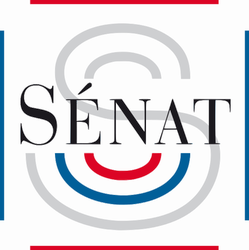
🌐suivre Marie-Anne Frison-Roche sur LinkedIn
🌐s'abonner à la Newsletter MAFR Regulation, Compliance, Law
____
► Référence complète : M.-A. Frison-Roche, audition par la Commission des Lois du Sénat sur la Proposition de Loi constitutionnelle relative à l'interruption volontaire de grossesse et à la contraception, 27 septembre 2022.
____
► Lire le dossier législatif, notamment l'exposé des motifs de la proposition de loi.
____
►Résumé de la présentation avant la discussion : ma contribution à la discussion nourrie et très large établie entre les représentants du Sénat et les administratrices et mes collègues, Elisabeth Zoller, Stéphane Mouton et Sophie Paricard, a plutôt consisté à développer la dimension concrète et pratique du sujet et la considération que celle-ci a sur la rédaction d'un texte, s'il venait à l'idée du Législateur de s'en saisir.
En effet, il s'agit non pas tant d'établir un droit subjectif, dont la dimension constitutionnelle en tant que telle peut poser techniquement problème, mais d'assurer son effectivité. Ce terme-même d'effectivité est utilisé par la proposition de loi. Or, la notion d'effectivité est utilisée dans le Droit économique, qui vise les buts, le Droit de la Régulation et de la Compliance visant à obtenir dans une sorte de réussite croissante l'effectivité, l'efficacité et l'efficience des mécanismes juridiques. Mais ce souci de politique publique est difficile à intégrer dans le système juridique, et ce que fait le Droit de la Régulation et de la Compliance est difficile à concevoir au niveau constitutionnel, la notion d' "accès à un droit" étant sans doute un pléonasme par rapport à la notion de "droit à l'effectivité", lequel vise sans doute les différents sujets de droit qui, dans la chaîne concrète qui jalonne la façon dont une femme dispose de son corps, deviendrait débiteurs d'un tel "droit d'accès à un droit".
Une telle notion peut engendrer de nombreux contentieux car les potentiels débiteurs d'un tel droit subjectif, qui aurait valeur constitutionnelle, ont aussi des droits subjectifs à opposer, et c'est une grande agressivité juridictionnelle des uns et des autres, des uns contre les autres, qui peut être ainsi engendrée.
D'ailleurs, placer dans la Constitution un tel droit subjectif sous "De l'autorité judiciaire" est inapproprié car le droit à l'avortement est protégé également par le juge administratif, non seulement à travers le contrôle objectif des textes mais encore à travers le contentieux subjectif, les établissements publics étant fortement impliqués dans sa mise en oeuvre.
En outre, de la même façon que l'arrêt Dobbs v. Jackson est un arrêt systémique, visant le fédéralisme, qui en application de la conception par la Cour de celui-ci peut et va priver d'autres droits subjectifs de leur protection constitutionnelle fédérale, le premier à tomber étant sans doute le droit des personnes de même sexe à se marier, mais d'autres peuvent venir, le Constituant français devrait d'ores et déjà (puisqu'il vise l'avenir) soit :
- viser une catégorie plus abstraite de droits subjectifs que le droit à l'avortement, en visant une catégorie . Mais comment délimiter cette catégorie ? comment le dire ?
- soit partir dans le système de liste (ce qui explique l'insertion dans l'article 16, qui met ce droit spécifique à l'avortement parmi une liste d'autres droits, et suppose donc qu'à chaque fois l'on prenne une autre loi pour mettre les autres ...
Cela suppose alors que le Législateur intervenir par à-coup, dans une liste que le juge aura bien du mal à interpréter, sans doute une "liste fermée"..., mais surtout intervienne en Ex-Post, à chaque fois qu'il pense qu'une agression est davantage probable sur un droit que sur un autre (car c'est le raisonnement ici suivi, l'arrêt Dobbs, qui ne concerne pas l'Europe, étant considéré par le Législateur français comme un "signal" de danger sur ce droit-là...) : mais le Législateur d'une part doit intervenir sur l'avenir et non pas sur le passé (les lois "en réaction" ne sont pas de bonne méthode) et doit être abstraites car c'est au juge de décliner sur des situations et droits particuliers (cf. Carbonnier et "l'effet macédonier"). Or, le Conseil constitutionnel n'est pas placé pour faire cela. Quel juge en France pourrait le faire ?
Malgré la bonne intention du Législateur, et en retournant les techniques juridiques dans tous les sens, l'on ne voit pas "quoi faire"...
Mais, puisque l'enjeu n'est pas tant l'existence d'un droit, mais l'effectivité de celui-ci, et l'efficacité d'un système médical et social à le servir dans la "réalité" des choses, pourquoi ne pas se tourner vers le Droit économique, Droit concret et téléologique par excellence ?
Dès lors, si le Législateur devait intervenir pour protéger davantage à l'avenir l'effectivité du droit des femmes à disposer de leur corps, c'est peut-être sous une forme plus incitative, en s'appuyant sur les entreprises qui, comme l'ont fait les entreprises américaines en aidant les femmes à voyager jusqu'aux Etats protecteurs, en ne communiquant pas des informations aux autorités publiques des Etats non-protecteurs, aident concrètement à l'effectivité des droits subjectifs qui sont concrètement menacés, maintenant aux Etats-Unis, éventuellement demain en Europe et en France.
Cela s'appuie sur le Droit de la Compliance.
____
Voir aussi
💬Frison-Roche, M.-A, "La Cour suprême a déclenché la bombe de la sécession. Que faire ?", 5 juillet 2022
💬Frison-Roche, M.-A, Droit à l’avortement : « Le processus de sécession est dans la décision », 27 juin 2022
📧M.-A. Frison-Roche, Seuls les droits subjectifs techniques ne sont pas touchés par l'arrêt Dobbs: c'est sur eux qu'il faut construire une nouvelle théorie de l'entreprise, 29 juin 2022
Sept. 25, 2022
Publications
🌐 suivre Marie-Anne Frison-Roche sur LinkedIn
🌐 s'abonner à la Newsletter MAFR Regulation, Compliance, Law
____
► Référence complète : M.-A. Frison-Roche, "Fonder la compliance", in Revue de l'ACE, La compliance, n° spéc. n°157, septembre 2022, p.17-31.
____
► Résumé de l'article : L'article traite le sujet en 20 étapes
- Pourquoi fonder les pratiques de compliance ? Pour des impératif pratiques
- Fonder les pratiques de compliance pour rendre supportables, car compréhensibles, les pouvoirs et les charges concentrés dans les outils de Compliance
- Fonder les pratiques de compliance pour maîtriser un savoir technique exponentiel
- Fonder les pratiques pour y trouver la part du Droit
- Fonder la Compliance sur les process d’efficacité
- Rendre supportable la Compliance fondée sur les process d’efficacité par un mix de procédure et d’éthique
- Les professionnels de la Compliance fondée sur des process
- La place particulière de l’avocat et du juge dans la Compliance fondée sur des process
- Fonder la Compliance sur l’obligation de donner à voir par avance que l’on se conforme à la réglementation applicable
- L’aporie de la Compliance fondée sur l’obligation de donner à voir par avance que l’on se conforme à la réglementation applicable
- Les charges engendrées de la Compliance fondée sur l’obligation de donner à voir par avance que l’on se conforme à la réglementation applicable
- L’impraticabilité de la Compliance fondée sur l’obligation de donner à voir par avance que l’on se conforme à la réglementation applicable
- Fonder la Compliance sur des buts substantiels ponctuels
- Les professionnels de la Compliance impliquées par la Compliance fondée sur des buts substantiels ponctuels
- Fonder la Compliance par des buts substantiels globaux et à venir
- Fonder la Compliance par les Buts Monumentaux, négatifs et positifs
- Les professionnels de la Compliance fondée sur les Buts Monumentaux
- La place particulière de la population concernée et de l'Etat dans la Compliance fondée sur les Buts Monumentaux
- La place particulière de l’avocat et du juge dans la Compliance fondée sur les Buts Monumentaux
- L'avenir du Droit de l'Avenir
____
____
____
lire la revue dans son intégralité
_________
Sept. 23, 2022
Compliance: at the moment

► Référence complète : M.-A. Frison-Roche, "Forêts en feu : effectivité de la sanction des auteurs, une logique de compliance environnementale à développer ?", NewsletterMAFR Law, Compliance, Regulation, 23 septembre 2022.
____
► S'inscrire à la NewsletterMAFR Law, Compliance, Regulation.
____
Dans un article publié le 23 septembre 2023 par le Huffington Post, Feux de forêts : près de 50 personnes interpelées, il apparaît que les feux qui ont détruit des milliers d'hectare de forêt cet été ont, pour 90%, été causés par des êtres humains, pour 30% d'une façon volontaire, que la plupart des auteurs ont déjà été retrouvés, sont déjà l'objet d'une procédure de sanctions pénales, voire ont déjà sanctionnés.
L'on peut se féliciter de l'efficacité du Droit pénal, qui interdit ce comportement, puisque les autorités publiques, gendarmerie, police et magistrature, sont intervenir vite et bien en Ex Post : les auteurs ont été retrouvés et ont été ou seront punis, en application du Droit.
Mais si l'on prend la question des incendies de forêt sous l'angle non pas de l'effectivité du Droit, qui interdit de mettre le feu volontairement, l'acte violant cette interdiction conduisant en Ex Post à la condamnation de l'auteur, mais sous l'angle de l'efficience de la règle, l'on observe que le But qu'il faudrait atteindre serait qu'il n'y ait pas, ou moins, de feu de forêts.
C'est pour cela que les feux de forêts sont sanctionnés, parce que la personne qui brûle une forêt, comme celle qui pollue une rivière, affecte durablement le système dans lequel nous vivons. Et il est encore plus dur et plus long de faire renaître une forêt que de dépolluer les rivières.
Or, dans le cas des pyromanes et des incendiaires, l'auteur cause à lui seul beaucoup de dommages, lesquels sont très difficilement réparables, et dans l'ampleur et dans la durée, la durée (la reconstitution des sols, la pousse des arbres, l'écosystème) étant le souci systémique central : l'enjeu est systémique et se situe sur l'avenir. .
La logique juridique efficace devrait être celle de l'Ex Ante, qui repose sur l'efficience de la mesure : or, celle-ci est-elle applicable, à travers l'effectivité de la sanction ? Justement, non .... Les chiffres et les informations rappelés par cet article le montrent particulièrement bien.
Si l'on prend la perspective de prévention, la meilleure pour éviter les incendies, puisqu'un seul geste cause un très grand dégât, il apparaît dans les informations disponibles, rappelées dans l'article que :
【1】Les auteurs d'infractions à l'origine de feux systémiques ont des profils très variés, à la fois socialement et psychologiquement
【2】Les capacités des auteurs d'infractions à l'origine de feux systémiques à comprendre ce qu'ils font sont très variés, un nombre important n'ayant pas compris les conséquences de ce qu'ils faisaient
Or, si l'on prend une pollution de rivière, qui est de même dimension systémique, l'infraction à l'origine étant le plus souvent commise par une entreprise, ces deux éléments sont inverses :
【1】Les auteurs d'infractions à l'origine de pollutions systémiques ont un profil homogène : le plus souvent une entreprise ayant fait le plus souvent un calcul d'intérêt
【2】Les auteurs d'infractions à l'origine de pollutions systémiques ont une capacité importante à comprendre ce qu'ils font, le caractère volontaire s'intégrant dans une causalité économique
Il en résulte que :
【1】Concernant les feux de forêts, la méthode Ex Ante de l'éducation qui fonctionne bien pour les pollutions systémiques, si l'on apprend aux entreprises qu'il est de leur intérêt à long terme de préserver la nature (la Convention judiciaire d'intérêt public ayant été étendue aux délits en matière environnementale à cette fin) va à l'inverse fonctionner très mal pour les feux de forêts, parce qu'il n'y a pas un groupe social à cibler particulièrement et parce que les personnes qui passent à l'acte ne sont pas toujours aptes à bénéficier d'une campagne éducative
【2】La méthode consistant à faire payer l'auteur pour qu'il répare lui-même le dommage, qui fonctionne sur les entreprises polluantes, condamnées à replanter massivement, à dépolluer les rivières, etc., voire à en prendre soin activement à l'avenir, ne peut pas fonctionner car la personne isolée n'est pas une structure économique, n'en a pas les moyens : on la condamne donc, et c'est normal, au plus à deux ans de prison, ce qui ne fait pas repousser les arbres.
Que faire si l'on veut qu'il y ait une corrélation entre le dommage causé dans le passé, et le souci de prévenir d'une façon systémique son renouvellement ?
Comment intégrer un souci de Compliance, qui fonctionne bien en matière de pollutions engendrées par les entreprises, dans des destructions systémiques de la nature, dont les feux de forêts sont un parfait exemple ?
Certes l'affectation de 3000 gendarmes, décidée par le ministre de l'Intérieur, pour accélérer l'Ex Post est une solution.
Si l'on en revient à ce souci de l'Ex Ante, sans doute une pédagogie générale est bienvenue : c'est toujours la solution proposée pour tout, de la lutte contre la désinformation, de la lutte contre la haine, de la lutte contre les incendies volontaires. C'est vrai, l'éducation de tous pour que naisse le souci d'autrui est l'Alpha et l'Omega, et les danaïdes ne doivent jamais se décourager.
Il ne faut pas se contenter de l'effectivité du Droit pénal.
Il ne faut pas seulement se reposer sur l'éducation de tous à propos des biens communs et de l'avenir du monde, dès le plus jeune âge.
Il faut aussi plus techniquement diffuser largement cette remarquable efficacité de la détection de l'information.
Le Droit de la Compliance, dont le secteur bancaire et financier a été le premier secteur à recevoir la logique et à mettre en place les "outils de la compliance" qui y correspondent, est avant tout un droit de l'information. Or, ce que montre cet article, ce n'est pas tant l'efficacité des sanctions, car elles ne le sont guère (comment punir efficacement des personnes qui ne se rendent pas forcément compte de ce qu'elles font, avec quel type de peine, au regard des dégâts systémiques causés ?).
Ici, les preuves ont été retrouvées sous la cendre, reconstituées, croisées par différents modes de preuve, notamment scientifiques, menant à la personne.
Cette efficacité de collecte d'information a été rendue possible parce que les différentes autorités publiques ont travaillé ensemble : gendarmes, policiers, magistrats, et l'on se souvient à quel point la population et les entreprises, libérant de leur travail au sein de l'entreprise des spécialistes pour que ceux-ci se portent volontaire, aillent immédiatement sur place et aident les autorités publiques.
Cette alliance entre les Autorités publiques, les entreprises en position de le faire (les "opérateurs cruciaux") et la société civile, socle du Droit de la Compliance, produit de l'information.
Cela permet ensuite des procédures rapides.
Comme dans la Compliance bancaire et financière, les systèmes bancaires et financiers étant pareillement "enflammés" par des abus de marché commis par des êtres humains, abus qui sont soit prévenus, soit immédiatement détectés et dénoncés aux autorités publiques, le Droit de la Compliance ayant pour objet de "prévenir et détecter" ces comportements pour protéger le système dans son ensemble et le préserver à l'avenir, il s'agit de perfectionner un système d'information (la loi dite "Sapin 2" n'étant qu'un exemple de cela).
C'est pourquoi dans les peines prononcées lorsqu'un "feux systémique" a été produit, même par quelqu'un qui n'a pas compris ce qu'il faisait, il ne s'agit pas tant de le punir mais peut-être de concevoir, à titre complémentaire une "peine de conformité", telle qu'elle existe en Droit de la Compliance, non pas à travers une Convention judiciaire d'intérêt public puisque l'auteur n'a pas les moyens de cela, mais peut-être à travers un travail d'intérêt général.
Parce que les forêts sont tout autant systémiques que les rivières mais que ceux qui les détruisent les unes ne sont pas du tout ceux qui détruisent les autres, il faut réfléchir à importer les solutions efficientes de la compliance environnementale fonctionnant pour les seconds aux premiers, puisque les punir n'est pas très efficient et les surveiller est impossible.
Sept. 21, 2022
Publications

🌐follow Marie-Anne Frison-Roche on LinkedIn
🌐subscribe to the Newsletter MAFR Regulation, Compliance, Law
____
► Full Reference: M.-A. Frison-Roche, "Compliance, the new legal way for human values: towards an Ex Ante Responsibility", in Evolução do Direito no século XXI. Seus princípios e valores: ESG, Liberdade, Regulação, Igualdade e Segurança Jurídica. Homenagem ao Professor Arnoldo Wald, vol. 2, Direito Privado, São Paulo, Editora IASP, 2022, pp. 977-983
_____
► Summary of the article: For the first time, the future is the first question for the Humanity. The classical legal conception of Tort Law concerns the Past, the philosophical conception of Hans Jonas, a Responsability for the Future, an Ex-Ante Responsability must become a legal notion.
Traditionally, the Legislator takes decision for the Future and the Judges takes ones for the Past, but now in front of the possible disparition of human beings on this planet, global and catastrophic perspective, all legal perspectives need to be used, breaking the classical repartition, in the priority of the future. To do something, the Responsability must be put on everyone in a legal force, not only on the classical subject of Law and because of past behaviors, but because the operators, States, firms, or individuals, are "in position" to do so.
This new "Ex-Ante Responsability" is an essential part of the Compliance Law, very new branche of Law, with an extraterritorial effect, to find immediate and active solutions for the future. Because the issue is global, international Arbitration is in position to apply the conception, because international arbitrators are the global judges.
This new conception of legal Ex-Ante Responsability, declared by courts, expressed human values, such as the concerns for the others, in concordance withe the humanist tradition of European and American Law, Compliance being not at all to obey regulations but to concretise an alliance a Monumental Goal, here for the preservation of human beings in the future, and the powers and the legal duties of corporate and people to do so.
____
________
Sept. 20, 2022
Interviews

► Référence complète : M.-A. Frison-Roche, "La raison d'être est avant tout une notion juridique", entretien in Notariat, La journée de la Raison d'Etre,
____
____
📚Lire le numéro complet dans lequel s'insère l'entretien.
____
🎥Regarder l'intervention en vidéo de Marie-Anne Frison-Roche à la journée du Conseil Supérieur du Notariat sur la Raison d'être.
____
Sept. 15, 2022
Conferences

 ► Full Reference: Frison-Roche, M.A., Régulation et Compliance, expression des missions d'un Ordre, in📅 Ordre des Géomètres-experts, Une profession face aux défis de la société, Le Havre, September 15, 2022.
► Full Reference: Frison-Roche, M.A., Régulation et Compliance, expression des missions d'un Ordre, in📅 Ordre des Géomètres-experts, Une profession face aux défis de la société, Le Havre, September 15, 2022.
____
📅 read the general of the manifestation de la manifestation (in French)
____
🎥watch the one-minute video summarizing the twenty-minutes intervention (in French)
____
🚧 read English Presentation of the Working Paper which has been the basis of this conference
► English Summary of this intervention: Professional orders should not present themselves as exceptions, however legitimate they may be, in relation to a principle, which would be the competitive system, but as the expression of a principle. This principle is expressed by two branches of Law whose importance is constantly growing in European Law, liberal branches which are based on the conception of economic life and the definition of company, turned towards the future: the Regulatory Law and Compliance Law, two branches of Law both related and distinct.
Indeed, and this is the topic of the first part, Competition Law conceives professional orders as exceptions since these "corporations" constitute structural agreements. French domestic legal system both consolidates the professional orders by backing them up to the State, which would sub-delegate its powers to them, but involves them in the questioning by the European Union of the States and their tools. Most often the temptation is then to recall with a kind of nostalgia the times when the professional orders were the principle but, except to ask for a restoration, the time would be no more.
A more dynamic approach is possible, in accordance with the more general evolution of Economic Law. Indeed, the Professional Order is the expression of a profession, a little-exploited concept in Economic Law, over which the Order exercises the function of "Second-level Regulator", the public authorities exercising the function of "First-level Regulator". The Banking and Financial Regulatory Law is built in this way and operates thank to that, at national, European, and global level. This is what should be linked.
The Professional Orders therefore have the primary function of spreading a "Culture of Compliance" among the professionals they supervise and beyond them (clients and stakeholders). This culture of Compliance is developed regarding the missions which are concretized by the professionals themselves.
Therefore, the second part of the Working Paper deals with the legal evolution of the notion of "Mission" which has become central in Economic and General Law, through the technique of the mission-based company. However, there are multiple points of contact between the raison d'être, the company with a mission and Compliance Law as soon as the latter is defined by the concrete and overly ambitious goals that it pursues. : the Monumental Goals.
Each structure, for example the French Ordre des Géomètres-Experts, is legitimate to set the Monumental Goal that it pursues and that it inculcates, in particular the conception of territory and the living environment, joining what unites all the Monumental Goals of Compliance: concern for others. The French Ordre des Géomètres-Experts, is adequate because it has a more flexible relationship, both tighter and broader, with the territory than the State itself.
By instilling this in professionals, the Professional Order develops in the practitioner an "ex ante responsibility", which is a pillar of Compliance Law, constituting both a charge and a power that the practitioner exercises, and of which the Professional Order must be the supervisor.
____
► to go further ⤵️
- Frison-Roche, M.-A., 📘Compliance Monumental Goals, 2021
- Frison-Roche, M.-A., 💻Appliquer la notion de "Raison d'être" à la profession du Notariat, 2021
________
Sept. 6, 2022
Hearings by a Committee or Public organisation
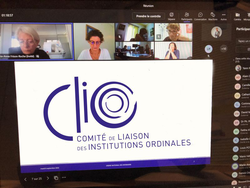
🌐suivre Marie-Anne Frison-Roche sur LinkedIn
🌐s'abonner à la Newsletter MAFR Regulation, Compliance, Law
____
► Référence complète : M.-A. Frison-Roche, Audition par le Comité de Liaison des Institutions ordinales (CLIO) sur "Europe, Compliance et Professions", 6 septembre 2022.
____
Cette présentation d'une quinzaine de minutes a ensuite donné lieu à un échange avec les membres du Bureau du CLIO.
____
► Résumé de la présentation : La perspective ici proposée est de partir non pas du schéma du marché concurrentiel, repris par le Droit de la concurrence, par rapport auxquels les professions et les ordres ont toujours dès le départ et définitivement statut d'exceptions, mais de partir - dans une vision paradoxalement moins juridique et plus concrète - de l'Europe telle qu'elle s'était construite à la fin de la Seconde Guerre mondiale et qu'elle se construit de nouveau.
I. LE PROJET POLITIQUE DE L'EUROPE : À COTE DE L'EUROPE DE LA CONCURRENCE, L'EUROPE DE LA RÉGULATION
La Régulation n'est en rien l'exception (qui serait en outre logée au niveau des Etats-membre) du Droit de la concurrence (qui serait en outre logée au niveau du Droit de l'Union), la concurrence écrasant doublement la Régulation, en ce qu'elle serait le seul principe (le principe prévalant sur l'exception) et qu'elle serait au-dessus dans la hiérarchie des normes.
Cela n'est pas vrai.
Il faut donc partir de l'Europe.
L’Europe est une idée politique, construite avec des moyens juridiques. C'est ainsi que Monnet l'avait conçu et c'est de nouveau que la Commission européenne la conçoit (voir par exemple ce qu'en dit Thierry Breton).
Au sortir d'une catastrophe, il s'est agi de construire l'Europe, conçue comme une communauté d’êtres humains (valeurs communes, groupe social fluide).
Pour cela, il fallait trouver les bons instruments juridiques, pour (re)créer ces valeurs communes : faire que les échanges se réalisent avec des règles juridiques "positives" (CECA, collaborations pour faire des rails) et des règles juridiques « négatif » (abattre les frontières ; prohibition des comportements anticoncurrentiels et prohibition des aides d’Etat, prohibition qui n’existe nulle pas ailleurs).
Puis en premier lier la Commission européenne, la Cour de justice, voire les Etats-membres ont « oublié » la construction positive et on n’a gardé que la construction négative : le vide concurrentiel (qui a des mérites, notamment en ce qu'il exprime la liberté), dont tout devait sortir ; en second lieu, on a pris l’instrument pour le but.
C'est ainsi que le Droit de la concurrence, en tant qu'il est une branche du Droit économique, est entièrement guidé par sa finalité, mais il a pour objet la concurrence : la téléologie a pour objet une fin qui ne lui est pas extérieure, c’est une « tautologie ».
L’Europe a changé, par le choc des crises successives depuis 2008, avec la crise financière et bancaire ; depuis 2020 avec la crise sanitaire ; depuis 2022 avec la crise climatique qui s’annonce.
C'est une opportunité (la crise est aussi une opportunité, parce qu'elle prise les idées de départ, fait de la place pour d'autres).
La téléologie européenne n’est plus tautologie ; la concurrence y retrouve sa place. Le système demeure celui d'une économie libérale mais la DG Concurrence ne résume plus la Commission européenne : l’Europe – y compris la Commission européenne – n’a plus pour seule fin la concurrence. La crise étant un souci majeur, car l'Europe a compris qu'elle était mortelle, le Droit a pour finalité de permettre à l'Europe de survivre (notamment face à la Chine : elle a pour fin d’être « durable » : de ne pas disparaître.
Cela a pris notamment forme dans l'Union bancaire, qui a pour but simple d'exclure la disparition de l'Europe.
Mais cela vaut aussi pour l'Europe de la communication des personnes et des biens. Voir par exemple la proposition le 7 juillet 2022 d’aides d’Etat sur les transports pour faire une Europe des transports avec des infrastructures publiques.
Voir aussi la naissance de la « gouvernance-énergie », signant la fin de la suprématie l’esprit de la directive de 2016 sur « l’ouverture à la concurrence » comme seul principe, nouant l'énergie et l'environnement, prolongeant la Régulation par la Supervision, c'est-à-dire avant tout l'Industrie. Or, dans une perspective à ce point concrète, là où il y a de l'industrie il y a des personnes ayant des savoirs-faire : des professionnels.
La crise de 2020 accélère la naissance de l’Europe de la Santé ; à partir du vaccin.
La DG Connect exprime volonté de construire un écosystème numérique européen : Europe des données, à la fois marchand, industriel et protecteur des personnes (Digital Markets Act ; Digital Services Act ; Governance Data Act ; Chip Act), initialement construit par le Juge européen (jugement de la CJUE Google Spain 2014).
Dans chaque perspective, il y a la fixation par les Autorités politiques européenne d'un « but monumental », à la fois propre à un secteur mais aussi commun à tous, et tous se regroupent autour d’une volonté proprement européenne : la protection des êtres humains.
L'Avenir de l'Europe est ainsi dans l'émergence de l'Europe de la Régulation.
La question qui se pose alors est : comment atteindre ces Buts ainsi politiquement posés ?
Car la distance est grande entre la volonté exprimée et la concrétisation de ces buts (affaire de "plan" et de "transition").
II. POUR CONSTRUIRE L'EUROPE SOUVERAINE : l'ACTION DES PROFESSIONS, ENTITÉS EN POSITION D'ATTEINDRE LES BUTS MONUMENTAUX
L’Europe de la Régulation, ainsi constituée, est, surtout avec l'enjeu des données (économie de l'information, industrie des données, souveraineté européenne), entre les mains des entreprises et de l'industrie, laquelle ne se pense pas en-dehors des professionnels.
La CJUE appuie le mouvement.
Mais comment la mettre en œuvre :
Le politique (la Commission européenne, les gouvernements nationaux, etc.) va rechercher des alliances, le Droit de la Compliance prolongeant le Droit de la Régulation et mettant en alliance les Autorités publiques (dont l'État n'est qu'un exemple) et les "entités en position de le faire".
Pour les institutions européennes, ces "entités en position d'agir" sont :
- :
- Les Etats membres
- Les entreprises cruciales, les entreprises publiques,
- Les ordres correspondent à cette définition
L'Europe se construit ainsi actuellement et à l’avenir sur deux piliers : Concurrence d’une part et Régulation et Compliance d’autre part.
- Ne pas se penser comme une exception (même légitime) au principe de concurrence
- Se penser comme un opérateur crucial contribuant à l'expression du second pilier de la construction européenne
- Donner à voir sa contribution structurelle à la construction de l’Europe, telle qu’elle se dessine
- Proposer son aide dans ce sens
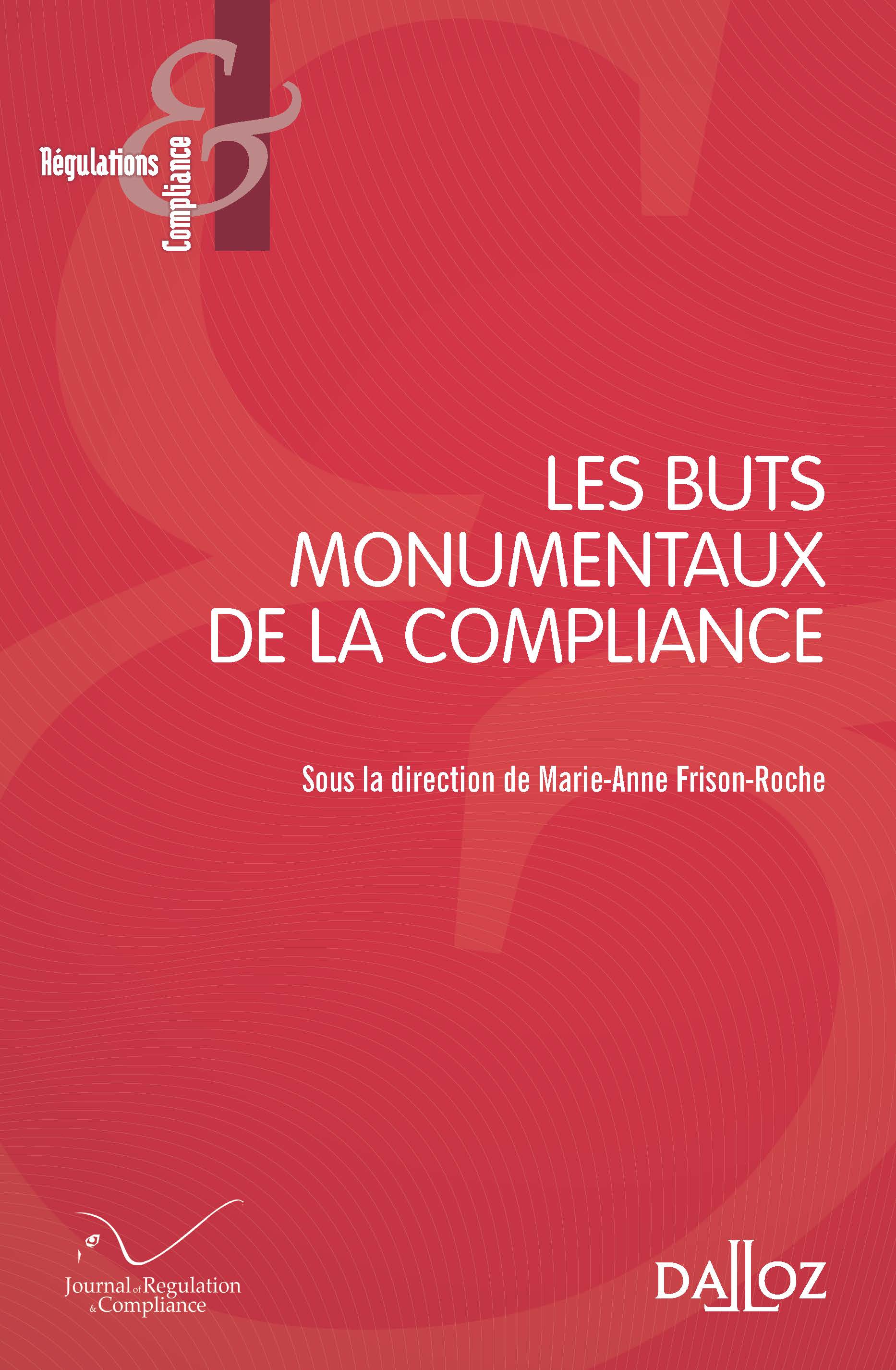
______
► pour aller plus loin ⤵️
- M.-A. Frison-Roche, 🎤 Régulation et Compliance, expression des missions d'un Ordre, 2022
- M.-A. Frison-Roche, 📕Les buts monumentaux de la Compliance,2022
- M.-A. Frison-Roche, 📕Les outils de la Compliance, 2021
- M.-A. Frison-Roche, 💻Appliquer la notion de "Raison d'être" à la profession du Notariat, 2021
- M.-A. Frison-Roche, 📕Avocats et Ordres au 21ième siècle, 2017
- M.-A. Frison-Roche, 📝Déontologie et discipline des professions libérales, 1998

Sept. 5, 2022
Publications


🌐 follow Marie-Anne Frison-Roche on LinkedIn
🌐 subscribe to the Newsletter MAFR Regulation, Compliance, Law
____
► Full Reference: M.-A. Frison-Roche, Compliance contract, compliance clauses, working paper, September 2022.
____
►Summary of this working paper: Compliance Law has multiplied obligations. However, although Tort Law is emerging in Compliance issues and contracts are multiplying in practice, for the moment the relationship between Compliance Law and Contract Law is not very visible (I).
However, there are contracts whose sole purpose is to give concrete form to Compliance, which creates a specific contract and must influence its implementation (II). Moreover, there is much to learn from the diversity of compliance stipulations scattered throughout a wide range of contracts (III).
________
🔓read the developments below⤵️
Sept. 1, 2022
Thesaurus : Doctrine
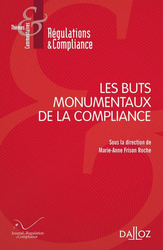
► Full Reference : G. Beaussonie, "Droit pénal et Compliance font-ils système ?" ("Do Criminal Law and Compliance form a system?"), in M.-A. Frison-Roche (ed.), Les Buts Monumentaux de la Compliance, coll. "Régulations & Compliance", Journal of Regulation & Compliance (JoRC) and Dalloz, 2022, p. 157-166.
____
📕read a general presentation of the book, Les Buts Monumentaux de la Compliance, in which this article is published
____
► Summary of the article (done by the Journal of Regulation & Compliance): By nature, Criminal Law is a system that is not intended to develop, principles which limit it being internal to it. Nevertheless if Proportionality is respected, its extension may be legitimate to preserve “fundamental social values” because Criminal Law is the branch of Law concerning what is grave, grave in consequences as in causes.
Not always being concerned by Efficiency, the temptation is important to supplement Criminal Law with other repressive mechanisms , not only Administrative Repression but today Compliance which pursues concordant objectives and aims by the "Goals Monumental ”to what would be most important and therefore for which Efficiency would be required, in particular because victory (for example against corruption) should be global.
Efficiency is obtained by the internalisation in powerful companies, but this efficiency comes at a price and Criminal Law should not impose too many obligations to do maintaining only a potential link with the commission of a "real offense ”. Its association with Compliance can therefore also only be exceptional and must not lead to forget that Freedom must always remain the principle.
________
Sept. 1, 2022
Publications
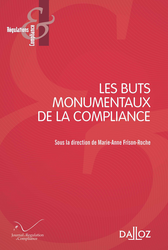
♾️follow Marie-Anne Frison-Roche on LinkedIn
♾️subscribe to the Newsletter MAFR Regulation, Compliance, Law
____
► Full Reference: M.-A. Frison-Roche, "Les Buts Monumentaux, cœur battant du Droit de la Compliance" ("Monumental Goals, beating heart of Compliance Law"), in M.-A. Frison-Roche (ed.), Les Buts Monumentaux de la Compliance, coll. "Régulations & Compliance", Journal of Regulation & Compliance (JoRC) and Dalloz, 2022, p. 21-44.
____
📝read the article (in French)
____
🚧read the bilingual Working Paper which is the basis of this article, with additional developments, technical references and hyperlinks
____
📕read a general presentation of the book, Les Buts Monumentaux de la Compliance, in which this article is published
____
► Summary of the article: Compliance Law can be defined as the set of processes requiring companies to show that they comply with all the regulations that apply to them. It is also possible to define this branch of Law by a normative heart: the "Monumental Goals". These explain the technical new legal solutions, thus made them clearer, accessible and anticipable. This definition is also based on a bet, that of caring for others that human beings can have in common, a universality.
Through the Monumental Goals, appears a definition of Compliance Law that is new, original, and specific. This new term "Compliance", even in non-English vocabulary, in fact designates a new ambition: that a systemic catastrophe shall not be repeated in the future. This Monumental Goal was designed by History, which gives it a different dimension in the United States and in Europe. But the heart is common in the West, because it is always about detecting and preventing what could produce a future systemic catastrophe, which falls under "negative monumental goals", even to act so that the future is positively different ("positive monumental goals"), the whole being articulated in the notion of "concern for others", the Monumental Goals thus unifying Compliance Law.
In this, they reveal and reinforce the always systemic nature of Compliance Law, as management of systemic risks and extension of Regulation Law, outside of any sector, which makes solutions available for non-sector spaces, in particular digital space. Because wanting to prevent the future (preventing evil from happening; making good happen) is by nature political, Compliance Law by nature concretizes ambitions of a political nature, in particular in its positive monumental goals, notably effective equality between human beings, including geographically distant or future human beings.
The practical consequences of this definition of Compliance Law by Monumental Goals are immense. A contrario, this makes it possible to avoid the excesses of a "conformity law" aimed at the effectiveness of all applicable regulations, a very dangerous perspective. This makes it possible to select effective Compliance Tools with regard to these goals, to grasp the spirit of the material without being locked into its flow of letters. This leads to not dissociating the power required of companies and the permanent supervision that the public authorities must exercise over them.
We can therefore expect a lot from such a definition of Compliance Law by its Monumental Goals. It engenders an alliance between the Political Power, legitimate to enact the Monumental Goals, and the crucial operators, in a position to concretize them and appointed because they are able to do so. It makes it possible to find global legal solutions for global systemic difficulties that are a priori insurmountable, particularly in climate matters and for the effective protection of people in the now digital world in which we live. It expresses values that can unite human beings.
In this, Compliance Law built on Monumental Goals is also a bet. Even if the requirement of "conformity" is articulated with this present conception of what Compliance Law is, this conception based on Monumental Law is based on the human ability to be free, while conformity law supposes more the human ability to obey.
Therefore Compliance Law, defined by the Monumental Goals, is essential for our future, while conformity law is not.
________
Sept. 1, 2022
Thesaurus : Doctrine

► Full Reference: B. Deffains, "L’enjeu économique de compétitivité internationale de la compliance" ("The economic challenge of international competitiveness of Compliance"), in M.-A. Frison-Roche (ed.), Les Buts Monumentaux de la Compliance, coll. "Régulations & Compliance", Journal of Regulation & Compliance (JoRC) and Dalloz, 2022, p. 355-366.
____
📕read a general presentation of the book, Les Buts Monumentaux de la Compliance, in which this article is published
____
► Summary of the article (done by the Author, translated by the Journal of Regulation & Compliance) : "Compliance", which can be define as obedience to the regulations is a stake for the company in that it can choose as a strategy to do it or not to do it, according to what costs it and brings it such a choice. This same choice of understanding is offered to the author of the norm, the Legislator or the Judge, even the entire legal system making regulation more or less expensive, and compliance with it for businesses. So when the French law known as “Vigilance law” was adopted in 2017, the French Parliament was criticized for dealing a blow to the “international competitiveness” of French companies. ”Today, it is on its model that the European Directive is conceived. The extraterritoriality attached to Compliance Law, often presented as an economic aggression, is nevertheless a consubstantial effect, with its desire to claim to protect beyond borders. , coming us back to a classic question in Economics: what is the price of virtue?
To fuel a debate that began a few centuries ago, it is on the side of the issues that the analysis must be made economically. Indeed, Compliance Law is not only located in Ex Ante, to prevent, detect, remedy, reorganize the future, but also claims to face more "monumental" difficulties than traditional branches of Law. And it is concretely by examining the new instruments that Compliance Law has put in place and offered or imposed on companies that the question of international competitiveness must be examined. The mechanisms of information, secrecy, accountability or responsibility, which have a great effect on the international competitiveness of companies and systems, have changed and their measure has not yet been taken.
________
Sept. 1, 2022
Thesaurus : Doctrine

► Référence complète : M. Segonds, "Compliance, proportionnalité et sanction" ("Compliance, proportionality and sanction"), in M.-A. Frison-Roche (ed.), Les Buts Monumentaux de la Compliance, coll. "Régulations & Compliance", Journal of Regulation & Compliance (JoRC) and Dalloz, 2022, p. 231-244.
____
📕read a general presentation of the book, Les Buts Monumentaux de la Compliance, in which this article is published
____
► Summary of the article (done by the Journal of Regulation & Compliance): Before devoting the developments of his article to the sole perspective of sanctions imposed under "Anti-corruption Compliance", the author recalls in a more general way that, as is the sanction, Compliance is in essence proportional: Proportionality is inherent to Compliance as it conditions any sanction, including a sanction imposed under Compliance.
This link between Proportionality and Compliance has been underlined by the French Anti-Corruption Agency (Agence française anticorruption - AFA) with regard to risk mapping, which must measure risks to arrive at effective and proportional measures. This same spirit of proportionality animates the recommendations of the AFA which are intended to apply according to the size of the company and its concrete organisation. It governs sanctions even more, in that punitive sanctions refer on one hand to Criminal Law, centered on the requirement of proportionality. Punitive sanctions It governs sanctions even more, in that punitive sanctions refer on the other hand to the disciplinary power of the manager who, from other sources of law, must integrate the legal requirement of proportionality when he/she applies external and internal compliance norms.
________
Updated: Sept. 1, 2022 (Initial publication: Oct. 14, 2021)
Thesaurus : Doctrine

► Full Reference: L. Rapp, "Conformité, proportionnalité et normativité" ("Compliance, proportionality and normativity"), in M.-A. Frison-Roche (ed.), Les Buts Monumentaux de la Compliance, coll. "Régulations & Compliance", Journal of Regulation & Compliance (JoRC) and Dalloz, 2022, p. 177-198.
____
📕read a general presentation of the book, Les Buts Monumentaux de la Compliance, in which this article is published
____
► Summary of the article (done by the Author): Proportionality is to the exercise of powers what subsidiarity is to the exercise of competences: an indicator as well as a limit. It determines the scope and allows for control at the same time. It sets the standard, before being a standard itself. This may explain why, in principle, it is part of the judge's office and his methods of assessment. But a study of its recent evolution shows that it is gradually moving from the ex-post to the ex-ante, which makes it possible to anticipate that it will soon become an effective tool of compliance policies and a useful normative reference. The article developments demonstrate this, by explaining how one slides from the principle of proportionality to proportionality control, from proportionality control to proportional reasoning, from proportional reasoning to compliance control, and finally, in a last desirable evolution, from compliance control to the necessary proportionality of control.
________